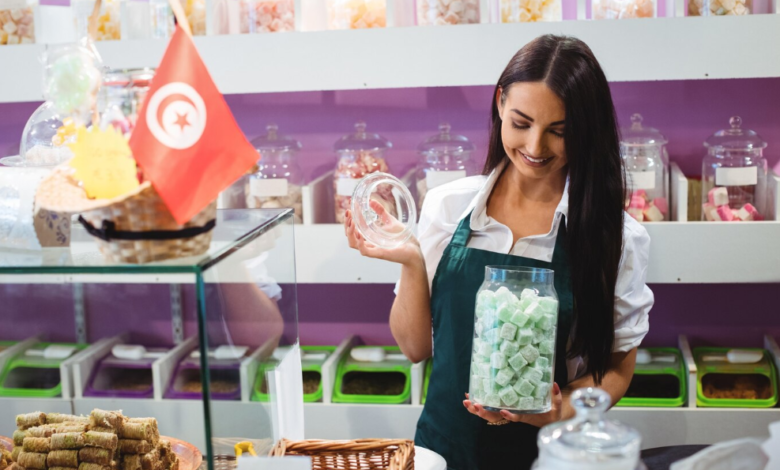The Pros and Cons of Owning a Candy Store Franchise

The Sweet Appeal of a Candy Store Franchise
Opening a candy store franchise can be pretty tempting, and for good reason. There are some definite perks that make it an attractive option, especially if you’re looking for a business with a built-in customer base and a proven system. Let’s break down some of the biggest advantages.
Brand Recognition and Customer Trust
One of the coolest things about buying into a franchise is that you’re not starting from scratch. People already know and (hopefully) love the brand. This instant recognition can save you a ton of time and money on marketing. Think about it: if you’re deciding between a no-name candy store and one with a familiar logo, you’re probably going to pick the one you recognize. This is especially true for kids (and let’s be honest, a lot of adults) who have specific candy brands they’re loyal to.
Established Business Model and Support
With a franchise, you’re not just buying a name; you’re buying a whole business model. This means you get a playbook for pretty much everything, from how to set up your store to how to handle inventory. The franchisor has already figured out what works and what doesn’t, so you don’t have to reinvent the wheel. Plus, you usually get ongoing support, which can be a lifesaver when you’re just starting out. Imagine trying to figure out all that stuff on your own!
Simplified Inventory Management
Managing inventory can be a real headache for any business, but franchises often have systems in place to make it easier. They might have preferred suppliers, automated ordering systems, or even just guidelines on how much of each product to stock. This can help you avoid overstocking (which leads to waste) and understocking (which leads to unhappy customers). Plus, because the franchisor has a good handle on what sells well, you’re more likely to have the right products on hand at the right time. And who doesn’t love a well-stocked candy store? I mean, imagine going to a candy store and they don’t have your favorite! That would be a disaster.
Franchises often have established relationships with suppliers, which can translate to better pricing and more reliable deliveries. This is a huge advantage, especially when dealing with perishable goods like candy. It also frees up your time to focus on other aspects of the business, like customer service and marketing.
Speaking of inventory, I wonder if they have what is cookie monster ice cream? I’ve been craving that lately. Or maybe an ice cream franchise would be better? Hmmm, decisions, decisions.
Navigating the Initial Investment for a Candy Store Franchise
So, you’re dreaming of owning a candy store franchise? Awesome! But before you get lost in visions of chocolate rivers and gummy bear mountains, let’s talk about the money. Getting started isn’t cheap, and understanding the costs upfront is super important. It’s more than just the franchise fee; there are build-out expenses, equipment, and the cash you’ll need to keep things running smoothly at the start. Let’s break it down.
Franchise Fees and Royalty Payments
Okay, first up: the franchise fee. Think of this as your ticket to the game. It’s a one-time payment you make to the franchisor for the right to use their brand, business model, and support. These fees can vary wildly depending on the brand’s popularity and what they include in their package. For example, a well-known ice cream franchise might have a higher initial fee than a smaller, newer candy brand. But it’s not just the initial fee you need to worry about. Royalty payments are ongoing fees, usually a percentage of your gross sales, that you pay to the franchisor regularly. These cover things like continued support, marketing, and brand development. It’s like a subscription fee for being part of the franchise family. Here’s a quick look at what you might expect:
- Initial Franchise Fee: $20,000 – $50,000+
- Royalty Fees: 4% – 8% of gross sales
- Marketing Fees: 1% – 3% of gross sales
Build-Out Costs and Equipment
Next, you’ve got the build-out costs. This is where things can get real expensive, real fast. You’re basically creating a candy wonderland from scratch (or renovating an existing space). This includes everything from flooring and lighting to shelving and display cases. And don’t forget the equipment! You’ll need things like refrigerators for chocolates, freezers if you plan to sell ice cream franchise products, cash registers, and maybe even a cotton candy machine. The costs will depend on the size of your store, the location, and the specific requirements of the franchise. For example, if you want to offer something like what is cookie monster ice cream, you’ll need the right equipment to store and serve it. Here’s a rough estimate:
- Leasehold Improvements: $30,000 – $100,000+
- Equipment: $15,000 – $40,000+
- Signage: $5,000 – $15,000
Working Capital Requirements
Finally, don’t forget about working capital. This is the money you’ll need to cover your day-to-day expenses while you’re getting your business off the ground. It includes things like rent, utilities, inventory, payroll, and marketing. It’s super important to have enough working capital to cover these expenses for at least a few months, especially since it can take some time for your store to become profitable. Underestimating this can be a huge mistake. You don’t want to run out of cash before you even get started! A good rule of thumb is to have at least 3-6 months’ worth of operating expenses saved up. Here’s a breakdown:
- Rent and Utilities: $2,000 – $5,000 per month
- Inventory: $5,000 – $10,000
- Payroll: $3,000 – $7,000 per month
Planning your finances is key. Don’t just look at the initial franchise fee. Consider all the costs involved, from build-out to working capital. Talk to existing franchisees, do your research, and create a detailed budget. This will help you avoid any nasty surprises down the road and set you up for success in the sweet world of candy store ownership.
Operational Challenges in a Candy Store Franchise
Running a candy store franchise isn’t all sweetness and light. There are some real operational hurdles you’ll need to clear to keep things running smoothly and profitably. It’s not just about stocking shelves with chocolate bars; it’s about managing the day-to-day realities of a retail business that deals with some unique challenges.
Seasonal Demand Fluctuations
Candy sales aren’t consistent year-round. You’ll see peaks around holidays like Halloween, Christmas, Valentine’s Day, and Easter. Then, there are the slower periods, like mid-January or August. The key is to plan your inventory and staffing accordingly. You don’t want to be overstocked with holiday-themed candy in February or understaffed during the Halloween rush.
Here’s a rough idea of how sales might fluctuate:
| Month | Sales Index (Average = 100) |
| February | 120 |
| April | 110 |
| July | 80 |
| October | 200 |
| December | 150 |
To manage these fluctuations, consider:
- Running promotions during slow periods.
- Adjusting your inventory orders based on historical data.
- Offering seasonal products that appeal to current trends.
It’s important to analyze your sales data from previous years to predict future demand. This will help you avoid costly mistakes and maximize your profits.
Managing Perishable Inventory
Candy, especially chocolate and certain types of gummies, has a shelf life. You need to rotate your stock regularly to ensure freshness. Nobody wants to buy stale candy! This is even more important if you decide to add an ice cream franchise component to your store. Imagine the waste if you don’t sell enough of that what is cookie monster ice cream flavor before it expires!
Here are some tips for managing perishable inventory:
- Implement a “first in, first out” (FIFO) system.
- Monitor expiration dates closely.
- Offer discounts on items nearing their expiration date.
Staffing and Customer Service
Finding and retaining good employees is always a challenge, but it’s especially important in a candy store. Your staff needs to be friendly, helpful, and knowledgeable about your products. They also need to be able to handle the occasional sugar-fueled meltdown from a child (or adult!).
Consider these points when staffing your store:
- Hire people who enjoy interacting with customers.
- Provide thorough training on product knowledge and customer service skills.
- Offer competitive wages and benefits to retain employees.
Marketing Your Candy Store Franchise Locally
Leveraging National Marketing Campaigns
National marketing campaigns from the franchisor are a great starting point, but you can’t just rely on them. Think of them as a base that you need to build upon. See what’s working nationally and figure out how to make it work locally. For example, if there’s a national promotion for a new type of chocolate bar, make sure you’re highlighting it in your store with eye-catching displays and maybe even offering samples. Also, consider tying it into a local event or partnership. If the national campaign is running a contest, promote it heavily in your store and on your local social media channels. This way, you’re not just passively participating; you’re actively engaging your local customers.
Community Engagement and Events
Getting involved in the community is huge for a [
The Competitive Landscape for a Candy Store Franchise
Running a candy store franchise isn’t all sugar and rainbows. You’ve got to be aware of who else is vying for the sweet tooth of your potential customers. It’s a pretty crowded market, and knowing your competition is half the battle. Let’s break down the main players you’ll be up against.
Competition from Large Retailers
Big box stores and supermarkets are a major source of competition. They have the advantage of scale, buying power, and established customer bases. Think about it: people are already in these stores for their regular groceries, and grabbing a bag of candy is an easy impulse buy. They often run promotions and discounts that smaller franchises might struggle to match. It’s tough to compete on price alone, so you need to focus on what makes your franchise special – maybe it’s the unique selection, the nostalgic feel, or the superior customer service. You might even consider offering something they don’t, like a specific ice cream franchise within your store.
Independent Sweet Shops
These are the local, often family-owned, candy stores that have been around for ages. They often have a loyal following and a reputation for quality and personalized service. They might specialize in certain types of candy or have their own homemade treats. Competing with these shops means understanding your local market and finding ways to stand out. Maybe you offer a wider variety of imported candies, or you create a fun, interactive experience in your store. It’s all about finding your niche.
Online Candy Sales
The internet has changed everything, and candy is no exception. Online retailers offer a huge selection, competitive prices, and the convenience of shopping from home. This is a big challenge for brick-and-mortar stores. To compete, you need to have a strong online presence yourself. This could mean offering online ordering, local delivery, or even just having an active social media presence to engage with customers. Think about offering exclusive online deals or creating content that showcases your unique products. For example, you could create a post about what is cookie monster ice cream and how it is made.
The candy market is constantly evolving. Staying informed about the latest trends, consumer preferences, and competitive strategies is key to long-term success. Don’t be afraid to experiment with new products, marketing techniques, and customer service approaches to stay ahead of the game.
Franchisor Support and Training for Your Candy Store Franchise
Starting a candy store, even with a franchise, can feel like jumping into the deep end. That’s where the franchisor comes in – they’re supposed to be your life raft. A good franchisor provides solid support and training to help you succeed. Let’s look at what that usually entails.
Initial Training Programs
Before you even open your doors, you’ll likely go through an initial training program. This is where you learn the ins and outs of the business. It’s not just about stocking shelves; it’s about understanding the brand, the operations, and the customer service expectations. The training usually covers:
- Product knowledge: Knowing your candies, chocolates, and other treats.
- Point-of-sale (POS) system: How to use the cash register and manage transactions.
- Inventory management: Ordering, stocking, and minimizing waste.
- Customer service: Handling customer inquiries and complaints.
- Store operations: Opening and closing procedures, cleaning, and maintenance.
Some franchisors might even offer on-site training at an existing store, so you can see how things work in a real-world setting. This hands-on experience can be super helpful. I remember when my cousin opened an [“ice cream franchise“], he said the initial training was intense but worth it. He even learned about “what is cookie monster ice cream” and how to make it look appealing.
Ongoing Operational Guidance
The support doesn’t end after the initial training. A good franchisor provides ongoing operational guidance to help you run your business smoothly. This might include:
- Regular check-ins from a franchise consultant.
- Access to a support hotline or online portal.
- Updates on new products and promotions.
- Best practices for managing inventory and staffing.
- Help with troubleshooting any issues that arise.
It’s like having a business coach in your corner. They’re there to answer your questions, offer advice, and help you stay on track. This is especially important during the first few years, when you’re still learning the ropes.
Marketing and Advertising Assistance
Marketing is key to attracting customers, and franchisors often provide marketing and advertising assistance. This can include:
- National advertising campaigns.
- Marketing templates and materials.
- Social media support.
- Local marketing strategies.
- Help with grand opening events.
Franchisors often have a marketing fund that franchisees contribute to, which is used to pay for national advertising campaigns. This can be a big advantage, as it helps to build brand awareness and drive traffic to your store. Plus, they usually have a good idea of what works and what doesn’t, saving you time and money on marketing experiments.
Long-Term Growth Potential of a Candy Store Franchise
Expanding Product Lines
Candy is great, but limiting yourself to just that might not be the best long-term strategy. Think about adding complementary items to your inventory. For example, gourmet chocolates, unique sodas, or even novelty toys can attract a wider range of customers. Consider seasonal items too, like special holiday-themed candies or decorations. This keeps your store fresh and interesting, encouraging repeat visits. You could even explore offering sugar-free or organic options to cater to health-conscious consumers.
Catering and Event Opportunities
Beyond the retail space, there’s a whole world of opportunities in catering and events. Candy buffets are super popular at weddings, birthday parties, and corporate events. Offering customized candy arrangements or party favors can be a lucrative side business. Partnering with local event planners or venues can help you tap into this market. Think about offering themed candy packages for different occasions. This adds another revenue stream and gets your brand out there in the community.
Multi-Unit Ownership
Once you’ve mastered the operation of your first candy store franchise, consider expanding to multiple locations. This allows you to scale your business and increase your overall profitability. Managing multiple units can be challenging, but it also offers significant rewards. You’ll need a strong management team and efficient systems in place to handle the increased workload. But with careful planning and execution, multi-unit ownership can be a great way to build long-term wealth. You could even consider an [“ice cream franchise”] to complement your candy store, or even offer “what is cookie monster ice cream” as a flavor option. An ice cream franchise could be a great addition to your candy store.
Diversifying your offerings and exploring new avenues for revenue generation are key to long-term success in the candy store franchise business. Don’t be afraid to experiment and adapt to changing consumer preferences. The candy industry is constantly evolving, so staying ahead of the curve is essential.
Wrapping It Up: Is a Candy Store Franchise Right for You?
So, we’ve talked about a lot, right? Owning a candy store franchise can be pretty sweet, with that built-in brand name and all the support you get. But it’s not all lollipops and gummy bears. You’ve got to follow the rules, and sometimes those fees can add up. It’s a big decision, for sure. Think about what you really want, how much work you’re ready for, and if you’re okay with someone else calling some of the shots. If you love candy and don’t mind playing by the book, it could be a good fit. If you’re more of a go-your-own-way type, maybe a different path is better. Just make sure you do your homework before you jump in. Good luck!




